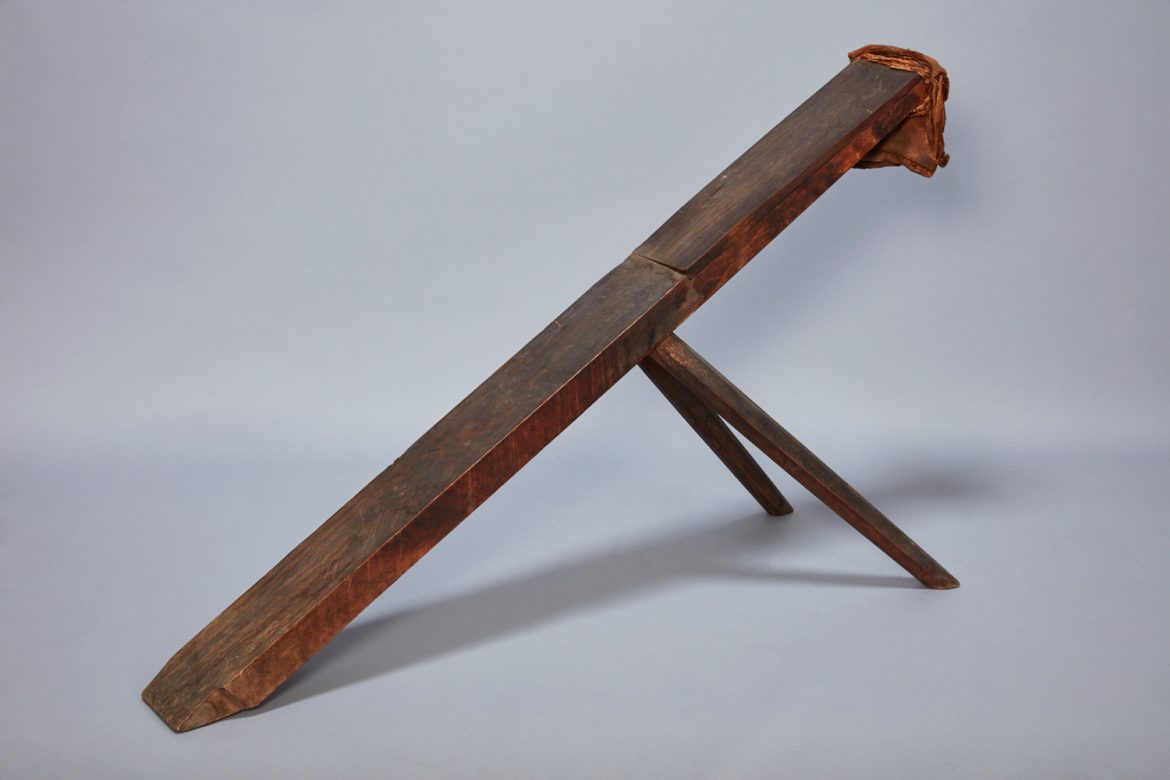
Fleshing Beam, Church Family, Mount Lebanon, NY, ca. 1840s, Shaker Museum | Mount Lebanon: 1961.13021.1. John Mulligan, photographer.
Agricultural pursuits were by far the most important economic engines supporting Shaker families and communities. Shaker farms produced food for the Shakers as well as excess products that were sold. In addition to farming, most Shaker families ran businesses that were designed to provide cash income for the families – cash to purchase the things […]
Agricultural pursuits were by far the most important economic engines supporting Shaker families and communities. Shaker farms produced food for the Shakers as well as excess products that were sold. In addition to farming, most Shaker families ran businesses that were designed to provide cash income for the families – cash to purchase the things that the Shakers did not or could not produce for themselves. Many of the products of these businesses – baskets, oval boxes, chairs, coopered-ware, cloaks, yarn swifts, palm-leaf bonnets, etc. – have become popular with antique collectors and essential elements in museum collections. While amazing numbers of these products survive today, there were important industries – sometimes gritty industries – that provided substantial income for some Shaker families but left little physical evidence of their importance. One of the grittiest of these industries was the tanning of hides. The Shakers in several communities operated large and profitable tanneries. The Church Family at Mount Lebanon may have had one of the most important and most successful of all of these operations. The Tan House still stands within earshot of the Meetinghouse but has been repurposed as a meeting hall and performance space for the Darrow School, the current occupants of the property. The 32 tanning vats in the cellar have been filled in and cemented over and little other evidence of the building’s original purpose is evident.

Fleshing Beam, Church Family, Mount Lebanon, NY, ca. 1840s, Shaker Museum | Mount Lebanon: 1961.13021.1. John Mulligan, photographer.
In 1961 the Darrow School held an auction of Shaker materials to raise funds for the planned conversation of the 1824 Meetinghouse into the school’s library the following year. The object discussed here, a fleshing beam from the Tan House at the Church Family, was purchased by the Shaker Museum at that auction.

The Beam House. Hausbuch der Mendelschen Zwölfbrüderstiftung, Band 2. Nürnberg 1550–1791. Stadtbibliothek Nürnberg, Amb. 317b.2°, from http://www.nuernberger-hausbuecher.de/75-Amb-2-317b-77-r/data, accessed October 10, 2017
In brief the tanning process alters the structure of an animal skin to slow its decomposition and make it more durable – sometimes adding color at the same time. The process always begins with an animal – animal skins (hides) were generally obtained from a slaughterhouse. At the slaughterhouse hides were quickly removed from the slaughtered animal and cured in salt or in the winter frozen to keep them from decomposing. Once they arrived at the tannery they were first taken to the beam house. Here the hides were soaked in lime water to soften hair and any remaining tissue. Following a soaking, the wet hides were placed on the fleshing beam where they were scraped with special knives on both sides to remove all hair and tissue. Once cleaned, the process of tanning – converting the skin to leather – could begin. There are about as many ways to tan a hide as there are different kinds of animal skins. There are both chemical and vegetable methods of tanning. The Shakers generally used tannins, organic compounds from which the trade of tanning takes its name, obtained from tree barks. The explanation of this chemical process is better left to chemists.
The fleshing beam, however, is a relatively simple tool that has changed little since its inception. It is a plank held up with two legs. Tanners prefer that their beams be held at about a forty-five degree angle and that they be sturdy. This beam is made of curly maple with a black locust inlay – the locust being very moisture resistant. It is supported on chestnut legs and has layers of cloth, paper, and straw to pad the upper end. The person using the beam stood at its high end, draped the wet hide over the beam, held it in place by pressing against the padded end of the beam, and scraped the skin with a knife in a downward motion.
Edward Deming Andrews wrote in The Community Industries of the Shakers (1932) that, “One of the most prosperous industries at the community of New Lebanon was the tanning of leather and such affiliated occupations as saddle, harness and shoe-making.” A small tan yard and tan house were set up there around 1787. The business was greatly improved when the current Tan House was built in 1834 and outfitted with efficient water-powered equipment. The related trades of saddle-making, harness-making, shoe making, braided horse and ox whips, and pads for a thriving business in hand cards for carding wool, provided these items for the family for sale at market.
While the Museum holds a number of tools related to the trades that made things from leather, there are relatively few tools in the collection that bear directly on the tanning industry. The fleshing beam is an unlikely survivor.